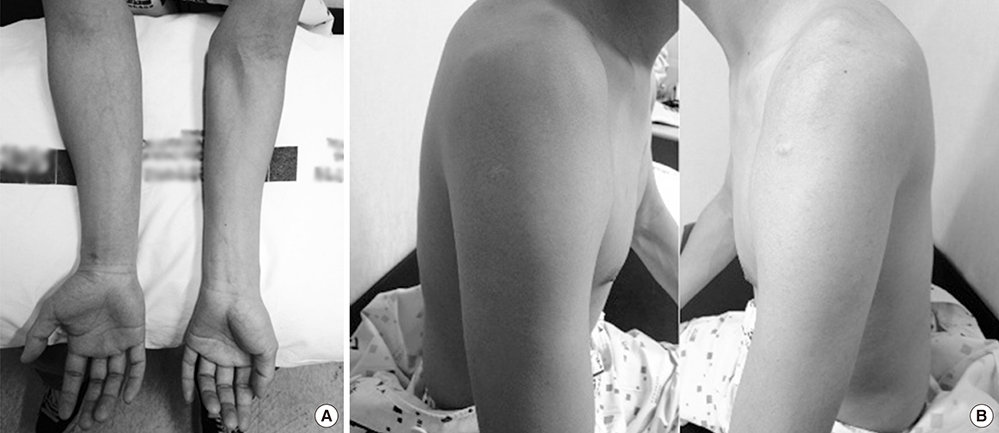J Korean Med Sci.
2016 Oct;31(10):1664-1667. 10.3346/jkms.2016.31.10.1664.
Hirayama Disease with Proximal Involvement
- Affiliations
-
- 1Department of Physical Medicine and Rehabilitation, Soonchunhyang University Cheonan Hospital, Cheonan, Korea. okokykkh@schmc.ac.kr
- KMID: 2468261
- DOI: http://doi.org/10.3346/jkms.2016.31.10.1664
Abstract
- Hirayama disease is a slowly progressing benign motor neuron disease that affects the distal upper limb. A 29-year-old man visited the hospital with a 1-year history of weakened left proximal upper limb. He was diagnosed with Hirayama disease 9 years ago, while there was no further progression of the muscle weakness afterward. Atrophy and weakness was detected in proximal upper limb muscles. Magnetic resonance imaging and somatosensory evoked potentials were normal. Needle electromyography showed abnormal findings in proximal upper limb muscles. Our patient had Hirayama disease involving the proximal portion through secondary progression. Clinical manifestation and accurate electromyography may be useful for diagnosis. Rare cases with progression patterns as described here are helpful and have clinical meaning for clinicians.
MeSH Terms
Figure
Reference
-
1. Hirayama K. Juvenile muscular atrophy of distal upper extremity (Hirayama disease). Intern Med. 2000; 39:283–290.2. Huang YL, Chen CJ. Hirayama disease. [ix-x.]. Neuroimaging Clin N Am. 2011; 21:939–950.3. Lim YM, Koh I, Park YM, Kim JJ, Kim DS, Kim HJ, Baik KH, Choi HY, Yang GS, Also-Rallo E, et al. Exome sequencing identifies KIAA1377 and C5orf42 as susceptibility genes for monomelic amyotrophy. Neuromuscul Disord. 2012; 22:394–400.4. Tashiro K, Kikuchi S, Itoyama Y, Tokumaru Y, Sobue G, Mukai E, Akiguchi I, Nakashima K, Kira J, Hirayama K. Nationwide survey of juvenile muscular atrophy of distal upper extremity (Hirayama disease) in Japan. Amyotroph Lateral Scler. 2006; 7:38–45.5. Gourie-Devi M, Nalini A. Long-term follow-up of 44 patients with brachial monomelic amyotrophy. Acta Neurol Scand. 2003; 107:215–220.6. Huang YC, Ro LS, Chang HS, Chen CM, Wu YR, Lee JD, Lyu RK. A clinical study of Hirayama disease in Taiwan. Muscle Nerve. 2008; 37:576–582.7. Yilmaz O, Alemdaroğlu I, Karaduman A, Haliloğlu G, Topaloğlu H. Benign monomelic amyotrophy in a 7-year-old girl with proximal upper limb involvement: case report. Turk J Pediatr. 2011; 53:471–476.8. Kwon O, Kim M, Lee KW. A Korean case of juvenile muscular atrophy of distal upper extremity (Hirayama disease) with dynamic cervical cord compression. J Korean Med Sci. 2004; 19:768–771.9. Schröder R, Keller E, Flacke S, Schmidt S, Pohl C, Klockgether T, Schlegel U. MRI findings in Hirayama’s disease: flexion-induced cervical myelopathy or intrinsic motor neuron disease? J Neurol. 1999; 246:1069–1074.10. Huh JP, Sung DH, Jo JM, Yoo JS, Kim BJ. Clinical characteristics, electrodiagnostic, and imaging findings of atypical forms of motor neuron disease. J Korean Acad Rehabil Med. 2010; 34:701–709.11. Hassan KM, Sahni H. Nosology of juvenile muscular atrophy of distal upper extremity: from monomelic amyotrophy to Hirayama disease--Indian perspective. Biomed Res Int. 2013; 2013:478516.12. Neves MA, Freitas MR, Mello MP, Dumard CH, Freitas GR, Nascimento OJ. Benign monomelic amyotrophy with proximal upper limb involvement: case report. Arq Neuropsiquiatr. 2007; 65:524–527.13. Lin J, Zhang W, Wang N, Gao D, Chen X, Li W, Zhang L. Hirayama disease simple presenting proximal upper extremity muscular atrophy. Chin J Orthop. 2011; 31:29–33.
- Full Text Links
- Actions
-
Cited
- CITED
-
- Close
- Share
- Similar articles
-
- Hirayama Disease with Isolated Spinal Cord Atrophy
- Juvenile Muscular Atrophy of the Upper Limb (Hirayama Disease): A case report
- Severe Spinal Injury in Hirayama Disease
- Probable Kennedy Disease Mimicking Hirayama Disease: A Case Report
- The Relationship Between Preoperative Cervical Sagittal Balance and Clinical Outcome of Patients With Hirayama Disease Treated With Anterior Cervical Discectomy and Fusion


